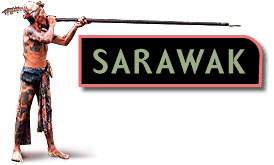

![]() Johor
Johor
![]() Malacca
Malacca
![]() Negeri Sembilan
Negeri Sembilan
![]() Selangor
Selangor
![]() Perak
Perak
![]() Kedah
Kedah
![]() Perlis
Perlis
![]() Pahang
Pahang
![]() Terengganu
Terengganu
![]() Kelantan
Kelantan
![]() Penang
Penang
![]() Sabah
Sabah
![]() Sarawak
Sarawak
![]() Kuala Lumpur
Kuala Lumpur
Sarawak is the largest state in Malaysia, a land rich in natural resources such as pepper, cocoa, palm oil, timber and oil.
Sarawak's history is reminiscent of an epic best-seller, filled with adventure and romance. When the English adventurer, James Brooke arrived in 1839, Sarawak was in a rebellion against the Brunei Sultanate. As a reward for the role he played in quelling the rebellion, the Pengiran Mahkota of Brunei made Brooke the Rajah of Sarawak in 1841. James was suceeded by his nephew Charles Brooke in 1868, who in turn was suceeded by his eldest son, Charles Vyner in 1917. During the Second World War, Sarawak was occupied by the Japanese forces but it was subsequently ceded to Britain after the war and became a British Crown Colony. Sarawak joined Malaysia in 1963 and today observes a democratic system of government.
With an area of 124,450 sq km, it is an endless discovery of fascination - the largest cave in the world, verdant jungles, unique fauna and flora, white beaches, and remote islands. An outback of sheer beauty! Add to it a population of 1.5 million people as rich and varied as its land, and you have the ultimate destination.
Being a vast state with areas of impenetrable jungle, travelling in some parts of the state is often by means of' light aircrafts and helicopters. Malaysia Airlines flies regularly to Kuching International Airport as well as to Miri from Kuala Lumpur, Johor Bahru, Singapore and Kota Kinabalu. Boats are a common mode of transport in Sarawak where its remote interior is crisscrossed with rivers. Major towns are provided with road, and serviced by buses.
Sarawak's capital is Kuching, an unusual name, since it means cat in the Malay language. But do not expect feline creatures to be any more than in any other place. Kuching sits on the banks of the Sungai Sarawak, approximately 32 km from the sea. The city reflects the influence of the West as it was for years the home of the 'White Rajahs'.
Sarawak also well-known with its hornbill.State of Sarawak also named Land Of Hornbill, because of hornbill is the state symbol.
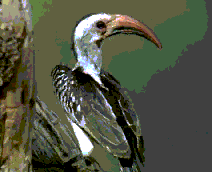 hornbill
hornbill
Hornbill, common name for any member of a family of birds found in Africa and Asia, that have large but lightweight bills. In certain small hornbills the bills may be brightly colored, reminiscent of those of the unrelated toucans of the tropical Americas. In some hornbills the bill is surmounted by a large projection called a casque.
Hornbills are relatively large birds, 61 to 152 cm (24 to 60 in) in length, and are black and white, gray, or dark brown in color. They are noted for their peculiar nesting habits. The female nests in a hollow tree, the opening of which she (helped by the male in some species) plasters over with clay mixed with salivary secretions, leaving only a small opening. While the eggs are being hatched, the male hornbill feeds the female through the opening in the tree. Most hornbills live in trees and feed mainly on fruit, except for the ground hornbills of Africa. These large terrestrial birds feed on small animals of all kinds; the more northern species, the Abyssinian ground hornbill, also joins vultures in feeding on carrion. The ground hornbills are the only members of the family in which the females are not sealed into the nest hole.
The largest member of the family is the rhinoceros hornbill, so named because its large casque is upturned, hornlike, at the anterior end. It inhabits the Malay Peninsula and several islands of the East Indies. Scientific classification: Hornbills make up the family Bucerotidae in the order Coraciiformes. The Abyssinian ground hornbill is classified as Bucorvus abyssinicus and the rhinoceros hornbill as Buceros rhinoceros.
![]() The Sarawak Cultural
Village And Herritage Centre
The Sarawak Cultural
Village And Herritage Centre
The Sarawak Museum is one of Asia's finest. It houses a collection of archaeological items. One of' the Museum's exhibits is the reconstruction of the great Niah Caves. You will be able to see the remains of the Neolithic people who lived in the Caves. The Museum is located in Jalan Tun Abang Haji Openg.It closed on Fridays and public holidays.
Named after the second Rajah's wife, Margaret, Fort Margherita was built in 1879 to serve as a fort of defence against pirates who came from the sea. It is now a Police Museum, housing weapons, including the only cannon to be cast in Sarawak.
Upriver from the Fort is the Astana. It was the residence of the second and third "White Rajah". It is now the official residence of Sarawak's Head of State. Built in 1874, it reflects Eastern and Western architecture.
Built in 1874, it is regarded as one of Sarawak's finest buildings. It has local art forms incorporated in the roof panels and on the door and window grills. The Court House was the seat of the government during the rule of the "White Rajah". The clock tower was added to the building in 1883. The obelisk memorial to Charles Brooke was commissioned in 1924.
Located at the junction of Jalan Tunku Abdul Rahman and the Main Bazaar, the Tua Pek Kong Temple is Kuching's oldest Chinese temple. It was built in 1876. Its famous celebration is the Wang Wang which commemorates the spirit of the dead.
The Hong San Temple was built in 1895, in honour of the God Kuek Seng. It is believed amongst the Chinese community that Kuek Seng became a god a thousand years ago. He is supposed to grant all requests from his devotees.
Situated in the heart of Kuching, this is a magnificent gilt-domed structure. It was built in 1968, on the very site of an old wooden mosque built in 1852.
The safari takes you on a four-hour journey along the Skrang River. Occasionally, you shoot the rapids. The journey brings you to Iban longhouses. You might be asked to partake in their ceremonies - which includes an offering of rice wine.
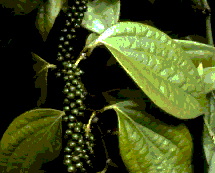 Native to India and long
considered the world's most important spice, the black pepper has
been used to flavor foods for over 3000 years. This plant
produces a single-seeded fruit called a peppercorn, which if
dried while immature and green, produces the spice black pepper.
Native to India and long
considered the world's most important spice, the black pepper has
been used to flavor foods for over 3000 years. This plant
produces a single-seeded fruit called a peppercorn, which if
dried while immature and green, produces the spice black pepper.
Sarawak is Malaysia's largest exporter of pepper. Pepper plantations can be seen along the Kuching-Serian Road.
A living museum indeed! Located at Santubong, the Sarawak Cultural Village conserves and portrays the multifaceted cultures and customs of ethnic groups such as the Ibans, Bidayuhs and Melanaus. The Heritage Centre is an integral part of the cultural village which offers traditional arts of Sarawakians.
 Traditional Craft Of Iban
Traditional Craft Of Iban
Opening hours: 9.00am -5.00pm
Cultural Show: 2-00pm-3-00pm
Fees: Adults: RM4 5 Children (6-12 years) - RM22-50 Below 6 - Free
 Mulu Caves
Mulu Caves
Nature left its best creation right here! Covering an area of 544 sq km, it encompasses the second highest mountain in Sarawak, Mt.Mulu (2,376 metres). The mountain has one of the most spectacular cave system on earth. Twenty-six major caves have been located, amongst them the Sarawak Chamber which is the largest in the world. The Mulu National Park has 1,500 species of flowering plants including 170 species of orchids, 67 species of mammals, 262 species of birds, 47 species of fish and 281 species of butterflies.
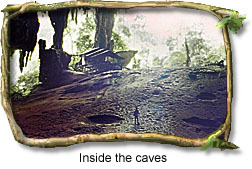 Gua Niah-Niah Caves
Gua Niah-Niah Caves
The Niah National Park covers an area of 3,103 hectares. The Great Cave, one of the largest in the world, is located here. Evidence of man's existence in Borneo dating as far back as 40,000 years ago was discovered in the Niah Caves. The skull of a young Homo Sapien, some tools made out of stone, bone and iron, and cave drawings were found. Anthropologists established that the Niahian lived in the Caves from 40000 BC right up to 1400 AD.
Compact little area of 26 sq m. Yet it has an abundance of flora and fauna. At least 7 major types of vegetation typical of Sarawak are found - the mangrove forest, sandy beach forest, sandstone cliff vegetation, alluvial forest, peat swamp forest, lowland dipterocarp forest and kerangas forest. There are well-marked jungle trails.
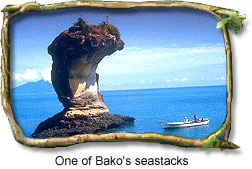
For sun and beach lovers, the coastline of the park provide sandy bays backed by steep cliffs. From October to March, the sea gets rough because of the monsoon and access to the Park may not be possible.
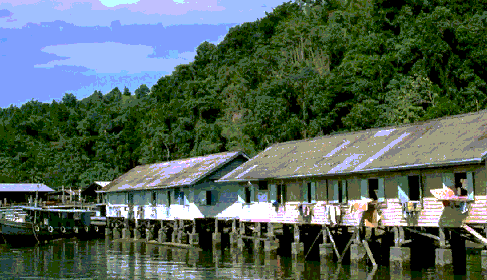 Fishing Village
Fishing Village
Besides having a good beach resort, Santubong is steeped in history, and provides interest to archaeologists. Hindu and Buddhist influences have been discovered around the Santubong River estuary. The area went through a "golden" era during the seventh and thirteenth century AD when gold was found here. The discovery of gold made it an important trading centre.
![]() States
States
![]() Tourism
Tourism
![]() National Symbols
National Symbols
![]() History
History
![]() Geography
Geography
![]() Flora & Fauna
Flora & Fauna
![]() Economy
Economy
![]() Culture
Culture
![]() Festivals
Festivals
![]() Transportation
Transportation
![]() Accommodation
Accommodation
![]() Foreign Exchange
Foreign Exchange
![]() Food
Food
![]() Fruits
Fruits